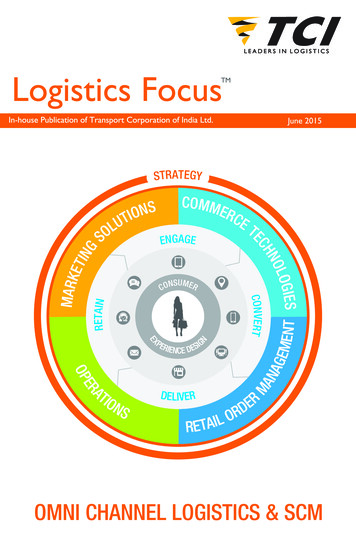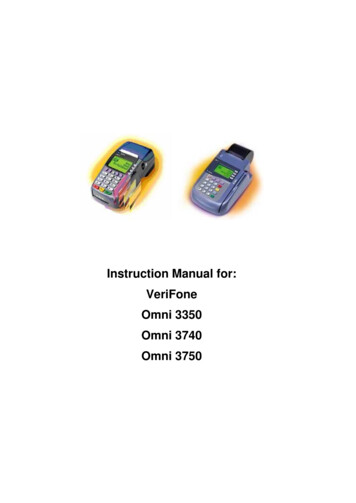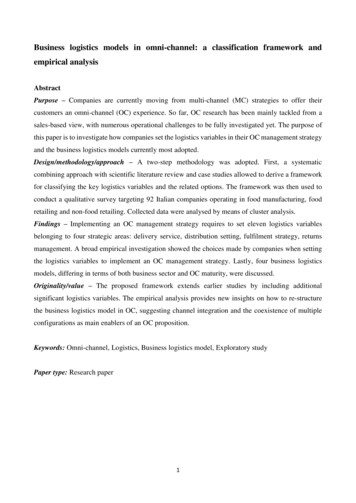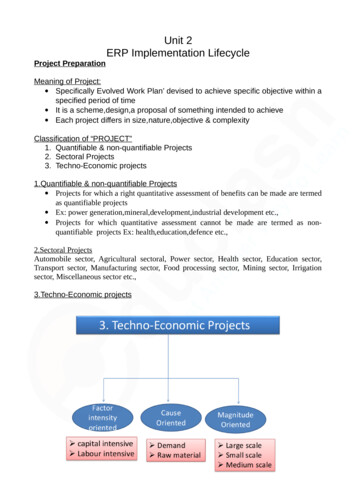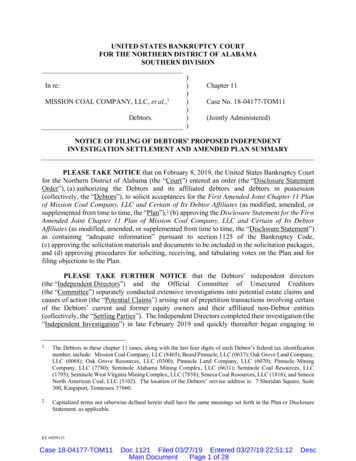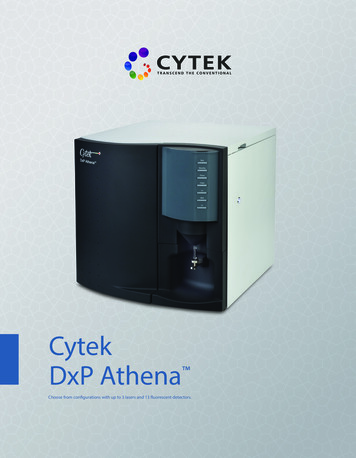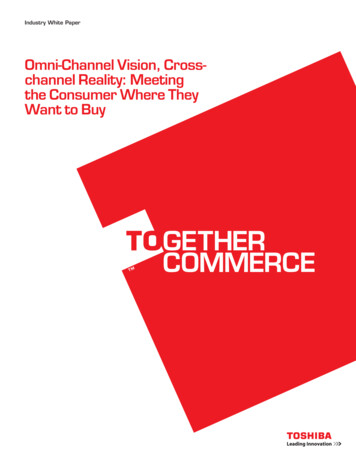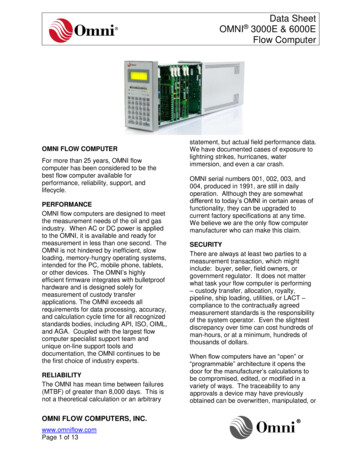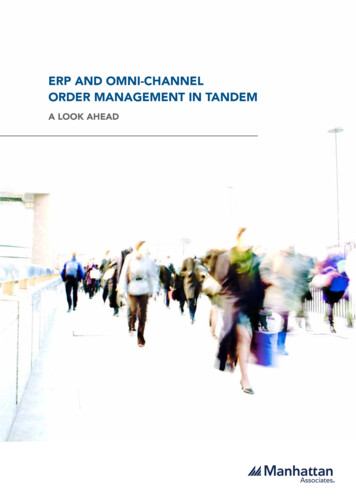
Transcription
ERP AND OMNI-CHANNELORDER MANAGEMENT IN TANDEMA LOOK AHEAD
How an order management layer can preventyour “good old” ERP software from sinkingyour omni-channel aspirations.For more than a decade, ERP systemssufficiently managed store, inventory andsupply chain operations, pushing goods tostores in lockstep with relatively static andstable demand forecasts.The following pages will describe what youneed to do to unlock more functionalityfrom ERP and get your system in tune withthe tempo and rhythms of omni-channelcommerce.But consumer demand in today’s era ofmulti-channel retailing is anything but staticand stable. The consumer’s expectation isto order anything, any time, from anywhere,and have it fulfilled at the place and timeof their choice. Traditional ERP systemsare not equipped to manage omni-channelorders that, by their nature, transcendonline and offline channels.“Our ERP system lacked flexibility tosupport future growth. Manhattan’sinnovative architecture will streamline ouromni-channel operations and enable usto give prompt responses to customers’inquiries on product availability and whenand how orders can be fulfilled.” - SeniorLogistics Director, Global Fashion Retailerand Distributor With More Than 2,000LocationsTo overcome ERP’s shortcomings withorder capture, product availability, orderorchestration, customer service andfulfillment, retail leaders havethree OrderOrderManagementManagementininTandemTandem
Stay the Course? Not AdvisableThe first option—forging ahead with the statusquo—ignores the incredible opportunitypresented by the multi-channel burgeon,disregards consumer desires, and puts theretailer at a disadvantage.The strategic work that animates importantbusiness outcomes always spans multipledepartments and many different data andprocess systems. The true way a companymeets or exceeds its strategic goals stems fromexecuting, monitoring and managing workto particular business outcomes. Today, thisprocess is “hand-stitched” by people, email,spreadsheets, ERP software, sticky notes andendless meetings. Think about what it takes tobring a new product to market, on-board a newvendor or customer, or fulfill a customer order.Add in the number of departments andsystems this type of work touches and whatit takes to get it done profitably and on time.The way people actually get work done simplydoesn’t map to the way traditional ERP hasbeen set up.Most ERP systems in use today werearchitected before “omni-channel” waseven a term.1 The business environmenthas changed many times since the originalrequirements were written at the start of theERP implementation project. Enterprise silossprung up that persist to this day. The brickand-mortar retail store was managed withmerchandising and replenishment software,whereas e-commerce was concerned withdiscrete orders and replenishing distributioncenters (DCs). These are fundamentallydifferent software constructs. That is why foryears retailers would run different softwarefor their retail operations and e-commerceoperations.2 For example, the idea ofdynamically shifting inventory betweenchannels is a foreign concept to ERP, otherthan an inventory transfer, which is meagerand insufficient to meet the requirements ofmodern omni-channel commerce.p/3ERP and Omni-Channel Order Management in TandemThe ERP “good enough” approach toextended functionality is not enough for muchmore challenging omni-channel requirements.The volatility of markets and consumer demandtoday require systems to support extremeagility in operations. But ERP systems werenever designed for agility.3 Newer analyticsand faster in-memory processing tools arehelping to a degree, but the underlyingapplications aren’t very agile.When Oracle Retail (Retek) and SAP Retail werebeing built (10-15 years ago), multi-channelconsumer behavior wasn’t on the radar. You caninnovate on the periphery (such as leveragingbig data for merchandising, pricing, etc.) butdrastic overhaul of the ERP core is massive andrisky. Adding customizations to an existing ERPsystem has been shown to increase the amountof support required to maintain the system.4SAP, in particular, can be difficult to change asa business evolves. According to PanoramaConsulting, this is because, “[SAP] is tightlyintegrated and helps enforce standardizedbusinesses processes across an enterprise,but it can also be more difficult to modify thesoftware to adjust to evolving core processesand requirements.”5The way people actually get workdone simply doesn’t map to the waytraditional ERP has been set up.
Rip-and-Replace?Not So Fast.The second option, a complete rip-andreplace, is not only cost-prohibitive, it tossesthe proverbial “baby out with the bathwater.”Few retailers are willing to risk the valueestablished by their ERP software at theexpense of new system implementation. Thisis because ERP systems have some importantcapabilities and assets such as: Data—massive amounts of transactionaldata about the company financials,customers, and information pertaining totransactions between trading partners.Activities—certain hard-coded activitiesthat execute discrete bits of processesknown as “business transaction events,”pre-packaged tasks that can be calledupon to perform process steps such as, forexample, “Pay the X Vendor” or “Checkthe Y Parts Inventory” or “Make a millioncopies of this widget in Hong Kong.”6Retailers cannot afford to abandon this troveof back-office transactional data. Indeed, it isnot the position of Manhattan Associates tosuggest that this needs to be done. Advancedorder management capabilities can be addedto your existing ERP investment, and is thepreferred route for many retailers that wantto deliver more options for fulfillment andinventory access to their customers.Indeed, technology advisory firm Gartnerpredicts that, “over time the current heavilycustomized ERP implementations will berearchitected to focus on ‘systems of record’functionalities—which should require littlecustomization—while the differentiatingprocesses and innovation activities will usealternative delivery models that are integratedwith the ERP system of record capabilities.”7p/4ERP and Omni-Channel Order Management in TandemAdvanced order managementcapabilities can be added toyour existing ERP investment,and is the preferred routefor many retailers that wantto deliver more options forfulfillment and inventoryaccess to their customers.
An Order Management Layer –The Right DirectionEnabling any-channel inventory agility throughthe integration of an order managementplatform atop ERP software allows retailersto choose the path already blazed by theconsumer. It empowers retailers to meetshoppers’ multi-channel expectations via anew level of order management agility notafforded by legacy ERP systems alone, andit promises significant efficiency benefitsrelated to the management of retailinformation systems.Along with agility, innovation must bequicker and specific to the new challengesretailers face every day. Companies likeManhattan Associates with its rapidinnovation cycles are more attuned to today’srequirements than large ERP companies.Big ERP players tend to be generalists withbroad, monolithic solutions that are hardto pivot the way retail and supply chainexecutives need to respond to today’schanging customer demands.The demands on companies to providea seamless, multi-channel shoppingexperience require a level of sophisticationorchestrated by distributed ordermanagement (DOM) software acrossretail operations, supply chain planningand supply chain execution. These arecapabilities that many ERP systems don’thave.p/5ERP and Omni-Channel Order Management in TandemThe software layer known as ordermanagement is quickly becoming theenterprise hub for selling and fulfillment.It’s a reality affirmed in The Forrester WaveTM:Omnichannel Order Management, Q3 2014report:“Order management solutions have evolvedto support a complex set of omnichannelorder fulfillment scenarios including ship-fromstore and store pickup. In addition, firms areincreasingly relying on their order managementsystems to fill the role of the enterprise-widesystem of record for order data. This meansthat not only is the order management systemacting as an order capture hub for online web,tablet, and mobile orders, but also for all salesthat originate via the contact center, point ofservice (POS), kiosk, or field sales force. Byconsolidating all order data from the acrossthe enterprise in one centralized repository,eBusiness professionals, with some help fromtheir customer intelligence colleagues, arenow able to view a customer’s complete orderhistory and purchase behavior.”8
SECTION TWOInformation Systems: The Casefor Order ManagementNo two retailers operate the same ERP infrastructure, sothe application of an order management platform thataccommodates the dynamics of multi-channel demand—whileensuring inventory accuracy—requires an organization-specificapproach.ERP system age and duplication are two common ERP scenarios thatpose challenges to multi-channel retailers.9Age. The older the ERP system, the morelikely that it was implicitly developed tohandle store inventory allocation alone.Legacy ERP systems that are rooted infinance don’t feature logic that allows themto allocate stock that doesn’t physically existwithin the “four walls” of the company. Norare they designed to readily re-allocate stockto another channel when necessary.p/6ERP and Omni-Channel Order Management in TandemDuplication. Whether the result of mergersand acquisitions or legacy, channel-specificsystem investments, many retailers operatemultiple ERP systems. In these situations,each ERP platform is subject to the resourceintensive and error-prone processes ofreplication and synchronization to ensureholistic data integrity and consistency ofsystems.
If you resell products or work with a partner fordistribution, it probably requires integration withmultiple enterprise systems. It is for this reason thatmost traditional ERP solutions will struggle with complexproduct returns—a return that starts in one distributionsystem but ends up in a different ERP system.Modern order management systems remove these burdensby centralizing business rules and data. This mitigatesthe risk of error while allowing the preservation of ERPinvestments.The same logic applies in situations where retailers havedeployed or acquired different web tools for differentweb channels or brands; the order management systemserves as the central source of inventory data andconsolidates the management of order flow amongthose varying systems. When correctly deployed,“DOM becomes an essential element in delivering ‘oneversion of the truth’ and a seamless experience to thecustomer.”10The order management platform enables data accuracyand quality. That’s a benefit also enjoyed by the retail ITdepartment, which can dedicate its resources to core ERPmanagement instead of managing ERP modifications andcustomizations. This frees the business and operationsteams to make progress with the agility and flexibilityafforded by the order management platform.In the modern, consumer-driven commerce environment,debating the merits of order management versus ERP isa false choice. Achieving front-end business agility withoutsacrificing accounting and finance functionality is a productof ERP and order management systems working together.Order management is as equally important fororganizations that sell directly to businesses, a marketthat Forrester calls B2B order management (B2B OM).According to Forrester, “[B2B OM products] complementyour existing ERP platforms by directing orders betweenERP instances, adding capabilities that many ERPs lack,and providing a consistent view of orders across all frontoffice systems.”11A common objection to adding an order management layer to ERP Systemsis introducing redundancy. In fact, the opposite is true. An order managementlayer should be considered an ERP enhancement for the modern age.p/7ERP and Omni-Channel Order Management in Tandem
CASE STUDY:Linking ERP and ManhattanEnterprise Order ManagementMoves Fashion ForwardA global fashion leader usesManhattan’s Enterprise OrderManagement (EOM) solution toorchestrate omni-channel retailoperations as the company continuesto grow. EOM fetches segmentedinventory information from the ERPsystem and surfaces availabilityinformation to customers browsing thecompany’s website and associates in thestore. When a customer order is createdin EOM, through the website, call center,or in-store, the ERP system is notified soinventory can be reserved or allocated.p/8ERP and Omni-Channel Order Management in Tandem
2Business Rules Simplified ByOrder ManagementERP systems are designed tointerface with a myriad of businesssystems, each with its own setof business rules. This web ofdisparate business rules cancreate pain for the retailer whenconsumer demand forces an agileresponse to market conditions.Order management removes thiscomplication by providing a centralbusiness rules repository that makesit easier for the merchant to meetinventory allocation and fulfillmentdemands from multiple channelssimultaneously.ERP systems can leverage seasonal,monthly and weekly historicdata that feed multiple backoffice functions and applications,particularly finance. Ordermanagement systems, on the otherhand, are more recently developedfor the business user to meet newbusiness requirements. When ordermanagement supplements thehistoric ERP purview with valuablereal-time data, stakeholders acrossthe enterprise benefit by facilitatingthe real-time movement of goodsand multi-channel sales that meetthe modern customer’s anytime,anywhere expectations.p/9ERP and Omni-Channel Order Management in TandemOrder management platformsenable a broad scope of businessrules that respond to modernmarket demands, many of which areincomprehensible in the standaloneERP environment. Some examplesinclude: Fulfillment optimization basedon real-time and extendedinventory dataAllocation rules based on nearreal-time demandOrder consolidationAverage total cost optimizationReal-time exceptionmanagement (as opposed tobatch exception management inERP systems)Product substitutions, packagingand promotion rulesReturns policies
3Order Management: Made ForMulti-Channel InventoryWhile ERP systems can link supply chainand inventory allocation processes forback-office purposes, they’re not builtto accommodate complete inventoryvisibility—from the depths of the supplychain to shelf and order levels—requiredof today’s multi-channel retailer. In reality,the ERP system only gains inventory visibilitywhen that inventory becomes physical stockvia receipt at the store or warehouse. Goodsin transit from suppliers or stored at supplierlocations are out-of-bounds for the ERP.What’s more, traditional ERP views stock inchannel- and supplier-specific silos. Thatapproach doesn’t align with the expectationsof the modern consumer.An order management system expandsthe view of available inventory beyond thefinance perspective (that inventory which canbe physically accounted for), to the businessmanagement perspective (that inventorybeyond the four walls which is available tosell).By broadening inventory visibility tothe supplier, third-party logistics (3PL)provider, and in-transit levels through ordermanagement, merchants can facilitate moresales through the expansion of productportfolios, brand offerings and saleschannels.p/10ERP and Omni-Channel Order Management in TandemTraditional ERP views stock inchannel- and supplier-specificsilos. That approach doesn’talign with the expectations ofthe modern consumer.
More Flexibility,More BenefitsThat the order management system isfast becoming the nucleus of the multichannel commerce experience is aproduct of its functionality, which enablesa host of benefits including:Traceability of inbound flow of goods, aswell as outbound order flow, includingmeans of fulfillment, delivery number anddelivery statusReal-time visibility into order statusThe customer loyalty-building ability ofaccurate “available to promise” goodsEnhanced visibility of goods in the supplychain, which reduces the risk associatedwith inadequate safety stockSimplified information systemsmanagement through easyintegration and aversion ofcustom developmentp/11ERP and Omni-Channel Order Management in Tandem
4The Right DirectionUsing traditional ERP is like using a papermap or atlas for navigation: processes arehidden, difficult to manage and adopt;task ownership is unclear; and there are noinstructions on what to do when somethinggoes wrong.In contrast, rules and workflow-baseddistributed order management softwareis like using a GPS app: one can visualizeprocesses; control and automate;collect metrics; improve process agility;and facilitate process optimization. Allthese cross-systems capabilities of theOrder Management software layer canimprove fulfillment process visibility,reduce process execution time, increaseefficiency, and drive continual processimprovement (CPI).By and large, retailers implementing ordermanagement systems are doing so toenhance and supplement—not to displace—their legacy ERP investments. They’re findingthat the order management investment notonly enables them to meet rapidly changingconsumer demand, it creates quantifiablebusiness efficiencies, particularly aroundinventory management, logistics andfulfillment.The need for a retail order managementsoftware layer has always been one of ERP’sshortcomings: it doesn’t meet the entirechallenge of multi-channel operations. Asmulti-channel consumer demand ramps up,progressive retailers will follow suit.p/12ERP and Omni-Channel Order Management in Tandem
Self-Assessment:Are Your Systems Up to the Task?p/13ERP and Omni-Channel Order Management in Tandem
5About Manhattan AssociatesWe believe that for brands to be trulycompetitive, the entire enterprise mustcontribute to winning and keeping thecustomer’s business. Making this happenmeans being flexible enough to respondefficiently and become drivers of revenueand relationships. And yet, to remainviable, organizations must carefully protectprofitability.Our Omni-Channel Central solutionsfunction as the operating system ofcommerce, enabling all points of sellingand service to have a common view ofboth customers and inventory, while alsoproviding the fine-grained controls neededto quickly adapt to changing sellingconditions. Omni-Channel Local solutionsbuild on the foundation of Omni-ChannelCentral solutions to enable store associatesto deliver high-touch selling and serviceexperiences, while seamlessly serving as anextension of your fulfillment network.See how Order Management Drives Order Accuracyfor David’s Bridal www.manh.com/davidsbridalp/14ERP and Omni-Channel Order Management in Tandem
Our Commitment to ERP UsersAdding order management and all of the benefits itbrings can breathe new life into the ERP system you relyon today.At Manhattan, we are committed to leveraging existingERP installations and extending retailer commercecapabilities through order management.We recognize that many retailers around the worlddepend on ERP systems that they have investedsignificant time and resources into installing andcustomizing. The good news is that it isn’t necessary toreplace your ERP in order to reap the benefits of omnichannel commerce.Contact us to learn more about how you can takethe ERP system you have today and bring it into theomni-channel era with the agility that you need to win inthe marketplace.“The legacy system could not pinpoint the exact location of stock andinaccurate data left us exposed in terms of the quality of customer servicewe were able to deliver. The [Manhattan] system met our needs in terms offunctionality and ability to be integrated with our legacy systems,”CFO, Leading Food Distributorp/15ERP and Omni-Channel Order Management in Tandem
Rashid, Mohammad et al. (2002). The Evolution of ERP Systems: A Historical Perspective.1Is Your Store Associate Ready for a Makeover? Webinar. Manhattan Associates. (2015). , Michael. (2004). The Struggle to Define Agility. CIO.3Koch, S., & Mitteregger, K. (2016). Linking customization of ERP systems to support effort: an empirical study. Enterprise Information Systems.4Clash of the Titans 2014: An Independent Comparison of SAP, Oracle and Microsoft Dynamics. (2013) Panorama Consulting.5BTE – Business Transaction Events “Demystified”. SAP Community Network blog post. Jan. 23, 2014.6Gartner Says by 2016, the Impact of Cloud and Emergence of Postmodern ERP Will Relegate Highly Customized ERP Systems to “Legacy” Status.7(2014) Gartner press release. Jan. 29, 2014.The Forrester Wave: Omnichannel Order Management, Q3 2014. (July 29, 2014). Forrester Research, Inc.8Retail Enterprise Resource Planning. DMSRetail. Retrieved Dec. 29, 2015.9RIS 2016 Store Systems Study. (2016) RIS News.10B2B Order Management Bridges the Gap Between B2B eCommerce and ERP. (2015) Forrester Research. March 27, 2015.11
Omnichannel Order Management, Q3 2014 report: "Order management solutions have evolved to support a complex set of omnichannel order fulfillment scenarios including ship-from-store and store pickup. In addition, firms are increasingly relying on their order management systems to fill the role of the enterprise-wide system of record for order .
